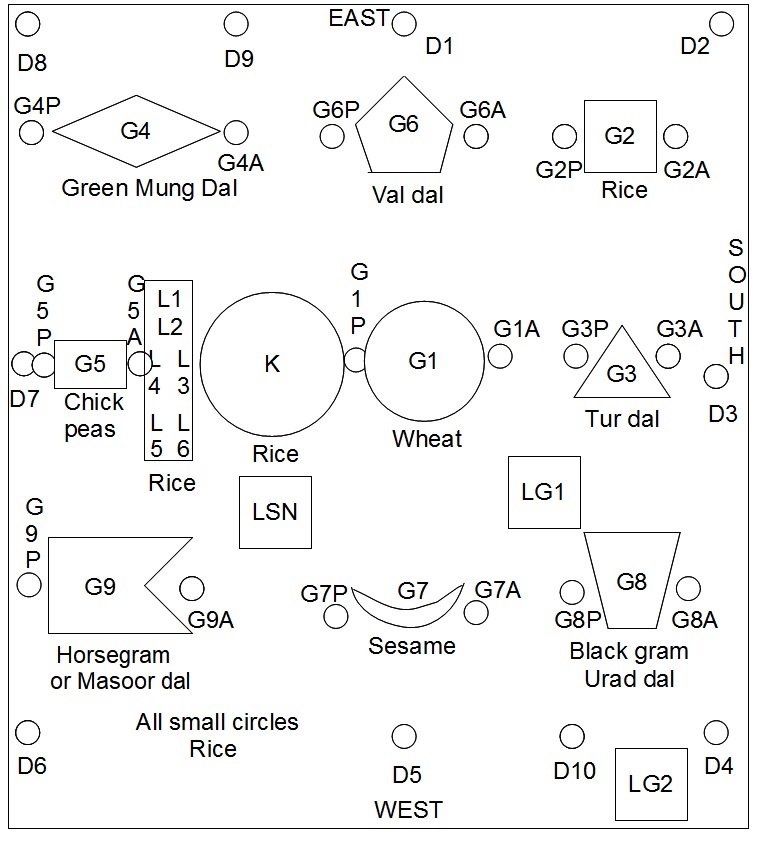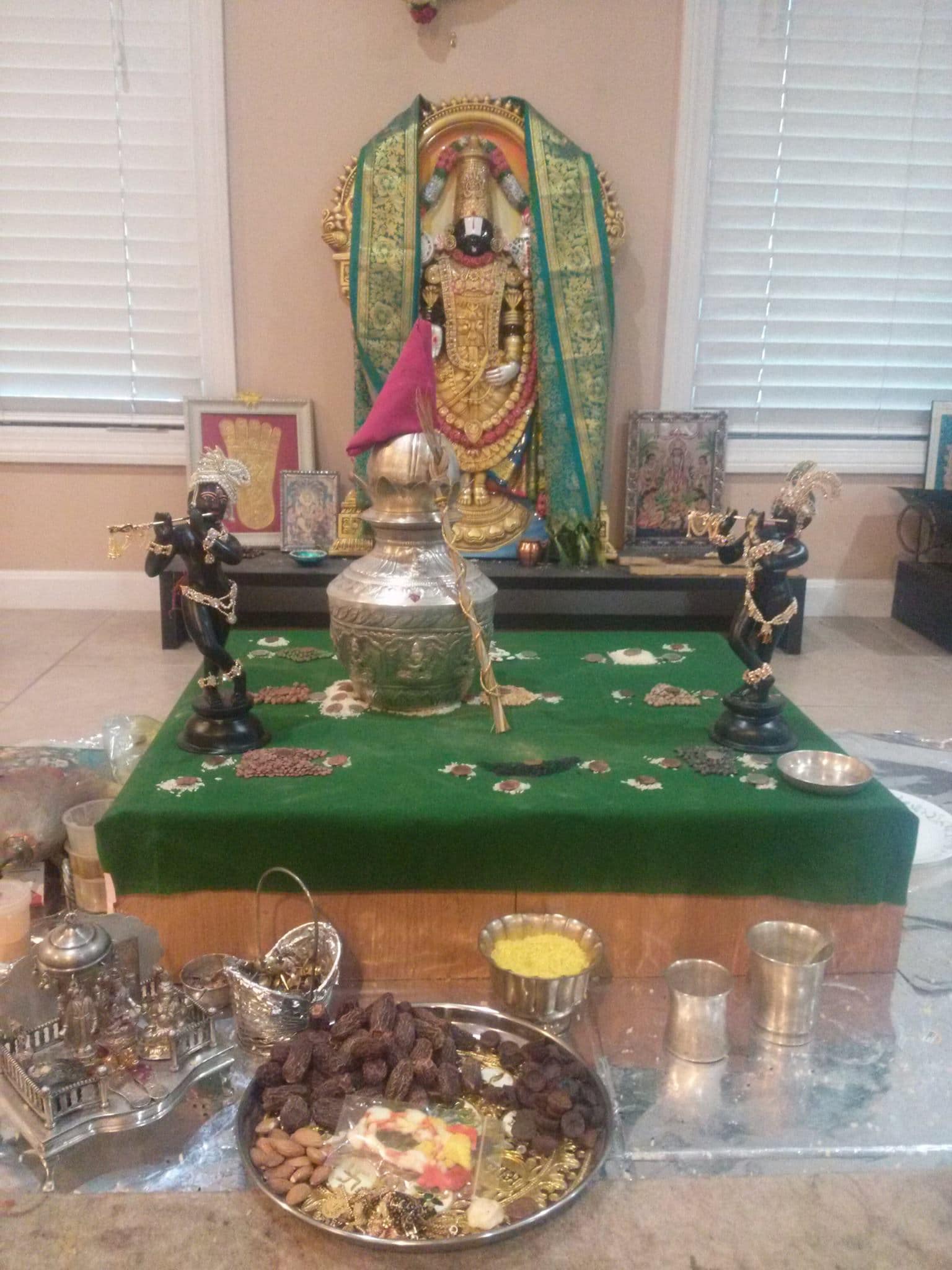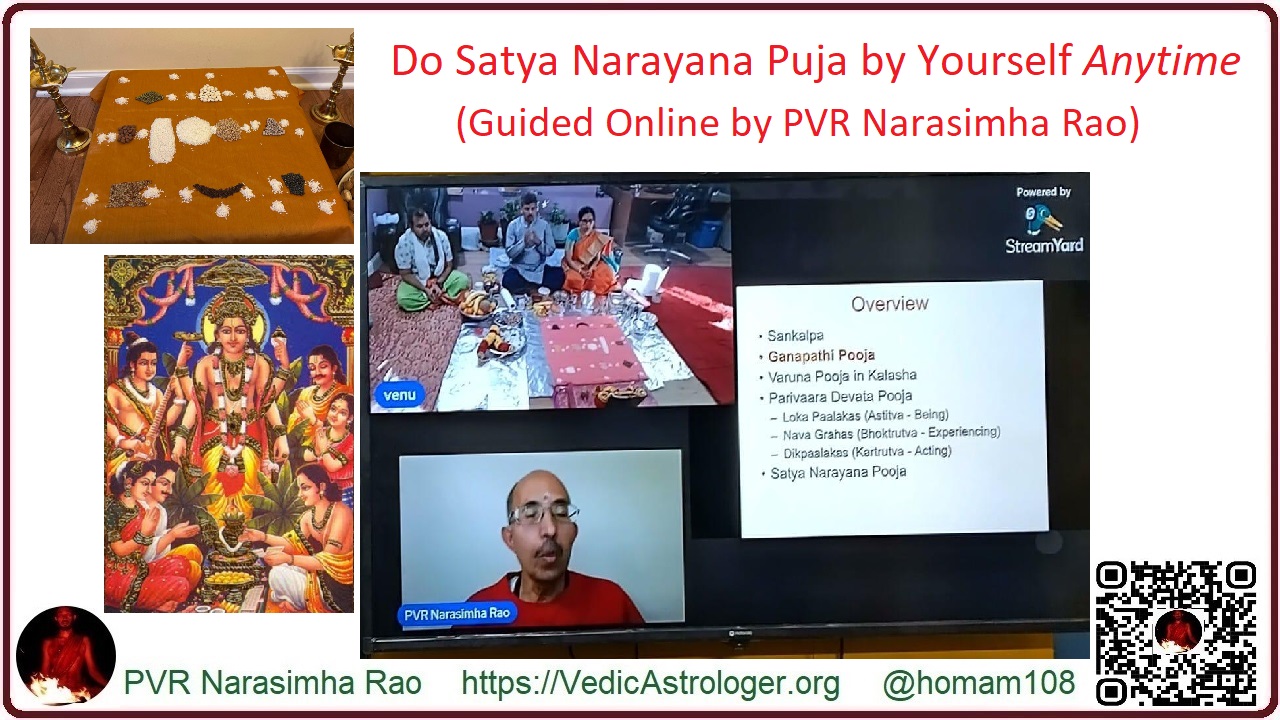Do Satya Narayana Pooja by Yourself Anytime
(guided online by PVR Narasimha Rao)
Importance of This Pooja
Satya Narayana Pooja is very effective in Kali yuga for overcoming various problems and making material and spiritual progress, as per Soota Maharshi (Vyasa Maharshi's sishya).
This pooja can be performed anytime one wants, but Pournima (monthly full Moon day), Ekadasi (11th day of waxing and waning fortnights) and Sankranthi (monthly solar ingress day) days are particularly auspicious for it.
Performing by Oneself Easily
Using this webpage and the video above, one can perform a detailed 3.5 hour pooja at home. In the video, PVR Narasimha Rao provides guidance. He chants the mantras and provides explanations and instructions (in English). He tries to facilitate people understanding the meaning of what they are doing, so that they can relate, visualize & feel the proceedings, rather than just mechanically doing something. One can pause, rewind and fast forward if needed.
Individuals or couples or families can perform this pooja. Please spread the word so that more people can benefit. 🙏🕉🙏
If someone benefiting from these resources wants to give dakshina for conducting the pooja, they can donate to a local temple thinking of PVR Narasimha Rao in mind.
Preparing For The Pooja
The video contains a window with PVR Narasimha Rao chanting mantras, giving explanations and instructions. Another window has a presentation with relevant details visually represented. A third window on the screen shows a couple following the instructions and actually doing the pooja.
Please get the "Materials Needed" (see below) and keep them near you while performing the pooja. Also follow "Preparations Before Pooja" below and be ready by the time pooja starts. Before you sit for the pooja, start playing the above video on a computer or phone and keep it near you. You should be able to hear the video well and preferably see the screen.
Try to connect to WiFi or have a reliable internet connection so that the stream is not interrupted. In case you miss a portion due to network problems, you can use pause and rewind as needed.
If one wants to chant the mantras along, while doing the pooja, one can download, print out and keep the "regular" manual handy.
English manual with mantras transcribed in English/Roman script: https://vedicastrologer.org/satya/pdf/satya_eng.pdf
English manual with mantras transcribed in Devanagari script: https://vedicastrologer.org/satya/pdf/satya_san.pdf
Materials Needed
- A murthi/idol of goddess Rama (Lakshmi) and Lord Satya Narayana. Otherwise, a murthi/idol of Lakshmi & Narayana. Otherwise, any murthi/idol. In the absense of idols, any golden or silver or copper or bronze or panchaloha or clay object or stone or coin can be used to invoke god in it.
- Some akshatas. Those can be made by mixing raw (uncooked) white (or brown) rice grains with a drop of sesame oil (or some other oil or ghee) and a pinch of turmeric powder. Instead of turmeric powder, one can also use vermilion (kumkum) powder used for the dot on the forehead. One can use plain uncooked rice also, if that turmeric (or vermilion) is not available.
- A small lamp, consisting of a wick that can be lit in sesame oil/ghee. A candle can also be used as an alternative, though it is better to burn ghee or sesame oil than wax.
- A match box to light fire
- Sandalwood powder
- One tumbler or cup to store water. It should preferably be made of silver or copper or panchaloha or clay. If unavailable, you may use steel or glass tumbler.
- One spoon (preferably silver or copper or panchaloha). If unavailable, you may use a steel or plastic spoon.
- Kalasha: One golden/silver/copper/bronze/clay pot used as kalasha (contains water and God is invoked in it along with the murthi/idol/coin). One coconut or any fruit (e.g. apple or orange) to put on top of kalasha as the head.
- Sugandha Dravya: Powder of cardamom, cinnamon, edible camphor and sandalwood to be mixed with the water in kalasha. If not available, just mix some sandalwood powder or turmeric powder.
- An incense stick or two
- Some flowers. If available, keep some red, white, yellow, blue and multi-colored flowers ready. If not, use any flowers. If no flowers are available, akshatas mentioned earlier can be used as a substitute.
- Some food that you can offer to god. Eggs, meat and seafood should not be used in that food. In fact, do not eat eggs, meat and seafood on the day of ritual. Onion, garlic, strong spices and too much of chillies should also be avoided in the food cooked for God. Fruits are also fine. Just jaggery or sugar or brown sugar or rock candy sugar can be offered to god too. When using sugar, please note that the normal white refined sugar used these days may have bone ash in it. Brown sugar, vegetarian sugar or jaggery are to be prefered. [NOTE: The scripturally recommended prasada (offering) for this ritual is made by cooking cream of wheat (or bulgur) in milk, ghee and sugar. If possible, one can make that.]
- A full fruit (e.g. banana, orange, apple, date, raisin) For making panchamrita: Milk, yogurt (curds), honey, ghee (i.e. clarified butter) and canesugar juice (or vegan/vegetarian sugar).
- Some water
- 45 dry dates (if not available, use green/yellow/brown raisins/kismis)
- 45 pieces of betel nut (if not available, you can just use askhatas mentioned earlier)
- 48 coins (any coins or metal/clay objects)
- A wooden plank or a table (optional)
- A piece of cloth, approximately 2 ft x 2 ft. It should basically be able to cover the wooden plank/table above completely. Any color except black is fine.
- Navadhanyas (nine grains used for nine planets) – rice, wheat, whole toor dal, whole green moong dal, whole chick peas, val dal, black sesame seeds, black gram (urad) dal and horsegram. All these are available in Indian stores. If not available, use just white/brown rice or any local grain in the place of all grains.
Preparation Before Pooja
- Make some food items to offer to god. You can just use rock sugar candy or raisins or dates or fruits or jaggery also. Please see the notes in the previous section on the scripturally recommended prasada.
- Fill water in the tumbler/cup and place the spoon in it.
- Fill the pot (kalasha) with water. Mix the powder (see “Sugandha Dravya” in the section above) in the water. Place a couple of coins in the water. Pour a few akshatas and a flower in the water.
- Place the coconut or other fruit (apple/orange) on top of the kalasha. Place this kalasha and idol in the pooja area.
- Optionally, you can put a wrapped cloth on top of the coconut/fruit which is on top of kalasha, as the crown. If you don't have a cloth or can't wrap it properly to make a crown-like thing, you can skip this.
- Prepare the Peetha: Take the wooden plank or table. Cover it with a piece of cloth. If you have no plank/table, clean the floor and place the cloth directly on the floor and use it as the peetha. Arrange various grains in various shapes in various positions as explained in "Arrangement of Peetha" below. The grain to be used is identified next to each shape in that picture. Go through the picture carefully. In the absence of correct grains, you can use white/brown rice or a local grain for all grains.
- Make a seat for yourself (or yourself and other family members participating) in front of the peetha. Ideally you should be facing east. You can decorate the idol and kalasha based on your ability and taste.
- Prepare panchamrita (5 ingredient ambrosia) by mixing milk, yogurt (curds), honey, ghee (i.e. clarified butter) and canesugar juice (or vegan/vegetarian sugar). For a smooth mixture, follow this procedure: (i) melt ghee, (ii) mix it smoothly with honey, (iii) mix canesugar juice or vegan/vegetarian sugar in it, (iv) mix yogurt/curds at room temperature (i.e. not cold from fridge) with this mixture, (v) make sure the mixture is homogeneous and then add milk at room temperature, (vi) make sure the resulting liquid is homogeneous. This is called panchamrita (5 ingredient ambrosia). If you can't make it, you can just milk or milk with some vegan/vegetarian sugar. Even water is fine.
- Important: Do not consume any food within 1-2 hours before the ritual (atleast one hour). Evacuate the bowels before ritual and take bath. Stomach should be empty during a ritual for the best experience.
Arrangement of Peetha
Try to sit facing east and keep the peetha (the wooden plank on which you place the cloth) in front of you. Various deities areinvoked during the course of the pooja in specific locations on the peetha. Their position will be marked in a video presentation in the live stream so you can locate them on your peetha and place the coin, date, betel nut and akshatas in the correct position.
But, before the pooja, arrange the peetha with various grains in various shapes as shown in this picture. If you don't have all the grains mentioned, use white/brown rice or a local grain for all grains.


Kalasha is placed at position marked as K.
Loka Palakas (ruler of 5 elements) are placed at positions marked as L1, L2 etc.
Grahas (planets) are placed at positions marked as G1, G2 etc.
Adhidevatas(ruling deities) of grahas are placed at positions marked as G1A, G2A etc.
Pratyadhidevatas(co-ruling deities) of grahasare placed at positions marked as G1P, G2P etc.
Dikpalakas (rulers of 10 directions) are placed at positions marked as D1, D2 etc.
Lord Ganapthi is placed at position marked as LG1 or LG2 (whichever you prefer).
Lord Satya Narayana is placed at positions marked as LSN.
You just arrange the grains on the peetha and keep ready before pooja. Placing kalasha and various deities on the peetha will happen in the course of the pooja. So, before the pooja, you should have something like the picture on the right, but without Kalasha and Krishna statues placed on the peetha.
Miscellany
As for the dress code, please wear what you normally wear for poojas or what is customary in your family/region. It is good to wear clothes that are comfortable and don't become a distraction to your mind during the pooja.
Also, we'll appreciate it if you can take a picture of your pooja set up after finishing the pooja (from any angle) and email it to pvr108@gmail.com.
Last Word (from PVR Narasimha Rao)
I have been doing this pooja on every Full Moon night since late 1999 and immensely enjoy it. I will try my best to guide you to perform a pleasant and blissful pooja and also share my insights along the way.
Pooja is supposed to an activity to relax, loosen oneself, enjoy and connect with the Divine. It is not meant to be a stressful activity. So kindly make the preparations to the best of your ability (and don't worry overly about any shortcomings) and enjoy the actual pooja. Don't be stressed out about mistakes etc.
🙏🕉🙏 ॐ नमो भगवते सत्यदेवाय Om Namo Bhagavate Satyadevaya 🙏🕉🙏